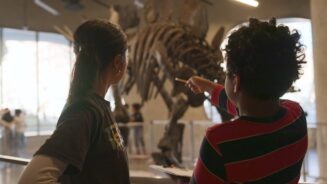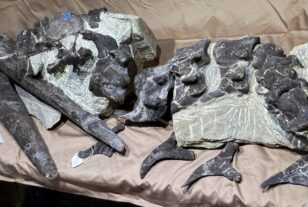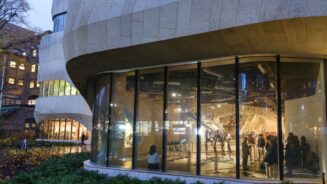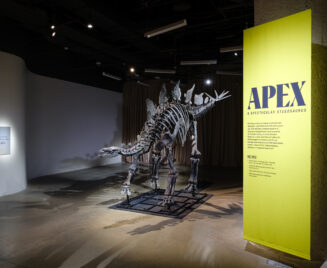Apex: The Dinosaur Teaching Millions About Our Past

- A 27-foot-long Stegosauraus skeleton, named Apex, uncovered in northwest Colorado in 2022, was put on display in New York’s American Museum of Natural History in late 2024 as the centerpiece of a four-year program of display, education, and research funded by Griffin Catalyst.
- Apex, which has been lying in the ground for over 150 million years, is one of the most complete Stegosaurus fossils ever discovered, with 80% of bones intact.
- Placed in a windowed alcove near the entrance of the Museum’s Gilder Center for Science, Education, and Innovation, Apex is visible not only to Museum visitors but the general public, and will become the focus of a new exhibition, extensive K-12 educational programs, and a postdoctoral research fellowship, all supported by Griffin Catalyst.
Apex offers a unique window into our planet’s distant past. I am grateful that millions of visitors and researchers will now be able to see and learn from this magnificent specimen of the Late Jurassic Period
In May 2022, a paleontologist named Jason Cooper was wandering his hundred-acre property in northwestern Colorado, not far from a town called Dinosaur. The town’s name is no accident: the entire area sits atop a famed geologic bed known as the Morrison Formation, where, since the 1880s, fossils of some of the world’s best-known dinosaurs—Allosaurus, Apatosaurus, Diplodocus—have been uncovered from its Upper Jurassic sedimentary rock.
That day, Cooper caught sight of a well-preserved dinosaur femur protruding from the surface, and, with growing excitement, spent the next several months with his team excavating the remainder of the discovery. What they found astonished them: a nearly complete Stegosaurus skeleton, 11 feet tall and 27 feet long, that had been lying in the ground for at least 150 million years. Scientists are typically delighted to locate a fossil that is 40% intact, and thrilled to discover one that is 60% intact; Cooper’s find was a remarkable 80% intact, with at least 254 of its 320 bones uncovered on site—one of the largest, most complete Stegosaurus specimens ever found.

In recognition of its extraordinary size and quality, Cooper’s team nicknamed their discovery “Apex,” and arranged for its sale by auction. Griffin Catalyst Founder Ken Griffin purchased Apex with the intention of loaning the specimen to a leading American scientific and cultural institution, where Apex could be enjoyed by a wide audience—including schoolchildren—and where scientists could carry out research to expand our understanding of the Dinosaur Age.
In what Ken has done working with other museums in the past, and especially what he has done with Apex, I think …he’s really looking at this as his opportunity to save a scientific object, and how that object can contribute the science at large.
A Jurassic Superstar Comes to New York
The American Museum of Natural History, in New York, which has been pioneering the discovery and exhibition of dinosaurs since the start of the 20th century, when it became the first place in the world to publicly present a Tyrannosaurus rex, jumped at the opportunity to display Apex. Building on Griffin Catalyst’s previous support, the Museum proposed an innovative idea for Apex’s initial presentation. In December 2024, the Apex skeleton was placed in a prominent display on the ground floor of the recently completed Richard Gilder Center for Science, Education, and Innovation, adjacent to the Kenneth C. Griffin Exploration Atrium—the soaring new gateway to the Museum.
Located here, just off the Museum entrance, and semi-encircled by large windows, the big Jurassic newcomer—positioned with its tail pointing toward the park—can be viewed not only by the Museum’s more than 4 million annual visitors but by anyone walking outside in Theodore Roosevelt Park or on the street—“a tremendous draw and star attraction,” the Museum itself notes, “alluring dedicated visitors and entranced passers-by alike.”

I think it's really important to bring kids ... to see exhibits like the Apex dinosaur, because it really helps them visualize what we're learning about when it comes to science. Coming to the museum really helps them see the scale and the size of what these things might've looked like. It's also really helpful because they always have a lot of volunteers here. They have a lot of information on the signs that really help answer the questions they might have that I might not be able to answer."
Education and Exhibition
The excitement about Apex’s arrival in New York offered an extraordinary opportunity for the American Museum of Natural History to expand its popular exhibition and education efforts, through a series of programs funded by a gift from Griffin Catalyst that accompanied the loan.
The world of dinosaurs captivates children like little else—and the Museum is eager to leverage Apex to spark a lasting sense of curiosity and wonder for our youngest learners.
Supporting the display of Apex is a multilayered education effort designed to engage young people at all levels, from elementary and middle-school children to college and graduate students.
Inspired by Apex and building on children’s intense fascination with dinosaurs, the Museum is creating new learning materials and activities to enhance its existing engagement programs, which already draw more than 200,000 students a year.
The Dinosaur Teaching Millions About Our Past
Meanwhile, an exciting online feature about Apex will be launched on the Museum’s science website for kids, OLogy. The Museum is also developing new curriculum modules, activities, and courses for early childhood, elementary, and middle-school learners, as well as materials for students in the Museum’s workforce development program, which trains NYC college students to become interns and docents, interpreting the Museum’s exhibits for visitors.
These audiences will engage with Apex through a cutting-edge science visualization effort, visiting Apex in-person and conducting their own 3D-scanning project before moving to the Gilder Center for Science, Education, and Innovation’s new Learning with Data classroom to visualize their scanned data as a 3D digital model. The larger goal for the Museum is to leverage young people’s special interest in prehistoric creatures toward an early introduction to scientific inquiry as a whole.

For most of 2025, Apex will remain alongside the Griffin Atrium while the Museum prepares a major new exhibition titled Impact: The End of the Age of Dinosaurs. In fall 2025, Apex will move to the fourth floor as part of a new show that tells the story of the meteorite impact 66 million years ago, a mass extinction event that brought the Age of the Dinosaurs to a sudden end.
Apex will remain at the Museum of Natural History for four years. Additional support from Griffin Catalyst will enable the production of a precise, life-sized cast of the specimen for the Museum’s permanent collection, a critical contribution to future research efforts.
A Unique Window to Our Past
As important as Apex is as a cultural attraction and educational tool, it is perhaps even more significant as the focus of a major research initiative, funded in part through Griffin Catalyst’s support. As an iconic American dinosaur from the Late Jurassic Formation, the Stegosaurus Apex holds special relevance to current research being conducted by the Museum’s world-renowned paleontology department. To advance that research, Griffin Catalyst is funding a new three-year Griffin Postdoctoral Fellowship for Paleontology to work with the division’s director, Dr. Roger Benson, to develop a new research program to glean insights about Stegosaurus biology.
Beautiful fossils that advance our scientific understanding of dinosaurs result from the hard work and passion and commitment of many people… And this commitment by Griffin Catalyst is allowing this fossil that otherwise might not be available for research to be available for scientists—not just here in the Museum, but through digital models of the skeleton available for researchers all over the world.
The research effort will seek to uncover answers to remaining questions about the Stegosaurus—and with it, the entire ecology of the Late Jurassic Period. One priority area of inquiry involves the size and age of dinosaurs. How quickly did Stegosaurus grow, and how quickly did it get to its full size? Microscopic analysis of the bone tissue of Apex, which scientists believe lived to adulthood and was already suffering from arthritis, will be compared to other Stegosaurus specimens, helping to establish growth curves for the Stegosaurus from small juveniles to mature adults—biological data not yet available.
To accomplish this foundational research, Dr. Benson and the Griffin Postdoctoral Fellow will carry out a comprehensive anatomical analysis, using 3D modeling from new CT scans performed by the Museum’s own imaging facilities. In the public-minded spirit that has characterized Apex’s journey from northwestern Colorado to the busy heart of New York, the Museum of Natural History will make this high-quality, finely detailed 3D data widely accessible through a global online repository.
As tens of thousands of visitors now experience for themselves this remarkable ambassador from Earth’s prehistoric past, so too will scientists all around the world be able to explore and interpret Apex to carry out their own research, and fuel new discoveries far into the future.






